|
Saddam Hussein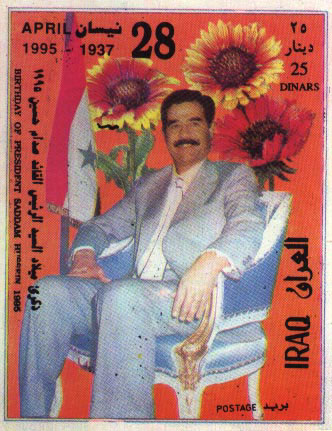 Saddam Hussein was a very, very bad man. But he's a Renaissance bad man -- a genocidal maniac with a collection of anthrax and bubonic plague samples, a power-mongering invader who married his cousin, a writer of romance novels and Broadway-style musicals, a dinner companion to Donald Rumsfeld and a recurring character on South Park.
Saddam Hussein was a very, very bad man. But he's a Renaissance bad man -- a genocidal maniac with a collection of anthrax and bubonic plague samples, a power-mongering invader who married his cousin, a writer of romance novels and Broadway-style musicals, a dinner companion to Donald Rumsfeld and a recurring character on South Park.
Then he was a rebel leader, just like Princess Leia, only less cute and less righteous. And possibly without the assistance of the Force. And finally, he was the Prisoner in Cell Block H. Or rather, Cell Block X -- the one you never come out of. Hussein was born in a small village in Iraq in 1937, where he joined the Ba'ath party at an early age. Iraq had once been one of the pinnacles of world civilization, but that was several centuries ago. By the time Saddam came on the scene, the country had track marks from repeated invasions out of Europe, most recently by the British. At the time of Saddam's teen years, anti-British sentiment was at its peak, due in large part to the Allies' support for creating Israel after World War II. By the 1950s, Iraq was in a fair amount of turmoil. A military coup declared the country a Republic, but Hussein's Ba'ath cronies made their own move and seized power in 1963. Although the party held power for the next several years, the chaos continued with rotating figureheads and lots of executions. What better time to be a rising young despot? Saddam married his cousin (a woman by the name of Sajida), fathered a couple of kids (including son Uday Hussein), and kissed a lot of asses as he bided his time. Throughout the 1960s and 1970s, Iraq repeated the cycle of coup, countercoup, and counter-countercoup, in several bloody iterations. The Kurds, an ethnic faction in Northern Iraq, staged occasional civil wars, with no success, even as the Soviet Union "took an interest" in the country's doings.
In 1979, enough top people were dead that the nation turned to Saddam Hussein. Or rather, Saddam Hussein turned on the nation, taking control after the resignation of his predecessor (who had been more or less his puppet for several years anyway). Hussein immediately executed many of his political opponents, quickly setting the tone for his regime (he's nothing if not consistent). He launched into a war with neighboring Iran, which for the world and the United States in particular, was one of those situations where you don't quite know who to root for. According to the official Iraqi government Web site, Saddam "Led the Iraqi people an army wisely and bravely against the aggression initiated and launched against Iraq by Khomeini's regime on September 4, 1980, which ended in Iraq 's great victory on August 8, 1988." The historical record offers a somewhat different version of events, with Iraq invading Iran in a war which ended with that most ignominious of conclusions, a U.N. brokered cease-fire. During the Iran-Iraq war, Hussein used poison gas on his enemies, and not just the ones in Iran. Those pesky Kurds tried Revolution No. 9 (more like 99, or 999), and they got a face full of toxins for their trouble. Saddam's move to gas the Kurds is a great talking point for some U.S. propagandists who gleefully note that the "Butcher of Baghdad" has "gassed his own people." The Kurds were poisoned mostly with Mustard Gas, which blisters the skin and lungs, as well as Nerve Agents and good old-fashioned cyanide. The downside to the whole "gassing his own people" angle is, of course, that the United States under President Ronald Reagan was actively supporting Iraq with logistical and military assistance at the time, in one of those little "proxy wars" with the Soviets that always turned out so well.
U.S. companies were recruited and encouraged, both covertly and overtly, to ship poisonous chemicals and biological agents to Iraq, by the administrations of both Reagan and George Bush Sr., according to the Washington Post and numerous other reports. The CIA also followed up on these efforts with various military and intelligence assists. U.S. care packages to Saddam included sample strains of anthrax and bubonic plague, which must have seemed like a really fucking great idea to someone at the time. With U.S. assistance and on its own initiative, Iraq also reportedly developed new and improved toxins, such as ricin and sarin gas. Torture was another tool in the Iraqi dictator's arsenal. When interviewed by a British reporter who nervously asked him if he used torture against his political enemies, he seemed puzzled by the question. "Of course," he said. "What do you expect if they oppose the regime?" Public sentiment in the U.S. slowly turned against Hussein into the early 1990s, what with all the gassing and killing and torture and whatnot, but policy lagged behind. Seeing the secular Iraq as a bulwark against the Islamic fundamentalists in Iran, the U.S. kept right on kissing Saddam's ass until he decided to invade Kuwait in 1991. At that point, the gloves came off. It's one thing to slaughter your own people in genocidal attacks with outlawed weapons, but it's another thing entirely to screw with the steady output of black gold, the life's blood of the world. President Bush Sr. successfully united a coalition of nations and led an invasion that drove Iraq out of Kuwait and destroyed much of the country's infrastructure.
Once the oil supply was secured, everyone cooled down, and the coalition decided to leave Saddam in power. He promptly returned to his prior policy of killing people, and the U.S. (now under President Bill Clinton) promptly returned to its policy of not giving a shit. The outright support of Saddam had now ended, of course, replaced with a series of tough economic sanctions. The sanctions helped kill even more of the Iraqi people, thus sparing Hussein the trouble of having to do it himself. As the Clinton era faded into a sex-soaked afterglow, it took about 30 seconds for the new George W Bush administration to start rumbling about Iraq. The rumbling really didn't have any legs, however, until the September 11 attack which leveled the World Trade Center and damaged the Pentagon. Almost immediately after the attack, Bush started making noises about Iraq, and the world started getting nervous. Although the attack was immediately blamed on al Qaeda and Osama bin Laden, there didn't seem to be much of a distinction between the two in the president's mind. Bush explained the connection to reporters in 2002: "This is the guy who tried to kill my dad." Around the same time, Bush's national security advisor Condoleezza Rice further explained the situation by saying "No one is trying to make an argument at this point that Saddam Hussein somehow had operational control of what happened on September 11." Note the phrase "at this point." The administration's attempts to tie al Qaeda and Iraq were controversial, largely because of the massive dearth of facts to support the contention. While no one doubted there was some degree of overlap between al Qaeda and Iraq ("the enemy of my enemy is my friend"), there has historically been little love lost between the two. In the aftermath of the devastating U.S. invasion of 2003, a horde of soldiers pored over Iraq with a fine tooth comb but found little convincing evidence that Hussein and Qaeda had any noteworthy connections, and no evidence at all that Iraq had any significant role in the September 11 attack. In fact, al Qaeda long considered itself an enemy of the Hussein regime. al Qaeda is an organization based on religious fundamentalism, the strictest and most inflexible interpretation of Islam, while Iraq is a secular regime with a history of waging war against Islamic fundamentalist regimes, namely Iran. Even as Saddam Hussein was gassing Iranian forces during the late 1980s, Tehran was providing critical support in the formation and financing of al Qaeda. Furthermore, Hussein repeatedly tried to manipulate the Muslim community into supporting his regime against the U.S. with shameless appeals to a religion for which he generally has no use. In an early 2003 statement denouncing U.S. plans to invade Iraq, Osama bin Laden nevertheless made a point of dissing the Hussein regime's moral bankruptcy (as opposed to his own self-perceived status as a paragon of moral rectitude). But no one ever let a lack of pretext get in the way of a good war, and Saddam Hussein didn't exactly try to avoid the inevitable. In March 2003, the juggernaut arrived in Iraq, despite opposition from nearly the whole world. Unlike in the first Gulf War, the U.S. sent ground forces into the country immediately and launched repeated "decapitation" strikes in attempts to assassinate Hussein, who stubbornly refused to die as requested.
Somewhat improbably, his exhortations were actually working, right up until he got caught. Although Bush declared "major combat" in Iraq a victory in May, the head of U.S. armed forces in Iraq said in July that an organized resistance was waging a guerilla war against the occupation, raising the prospect that U.S. troops might have to stay in the country for years to come. The prospect of a long-term guerilla war was also complicated by new revelations that the U.S. and British basically had no real evidence that Iraq was hoarding weapons of mass destruction, the primary justification for the invasion. Under Hussein, Iraq repeatedly violated various agreements regarding weapons inspections, to the point that even the bleeding heart liberals assumed he actually did possess terrible and dangerous weapons. However, none of those terrible and dangerous weapons were used in an attempt to repel the U.S. invasion, and a vast search effort found absolutely zilch-zero Biological Weapons, chemical weapons or nuclear weapons (as of this writing). If the guerrilla war drags on for months or years, the U.S. could find itself in deep trouble with Middle Eastern Muslim states in light of the utter lack of evidence that Saddam was doing any of the things the Bush administration accused him of. The administration can always fall back on colorful anecdotes, of course, if the evidence doesn't bear out their war-mongering. For instance, did you know that Saddam was so relentless in his pursuit of evil that he didn't even consider the proposition made by former Italian porn star, la Cicciolina, who offered to be the Butcher of Baghdad's fuck-toy in exchange for world peace. Now that's nefarious!
The king avenges her death, then attempts to give constitutional-style freedoms to his people. The effort backfires, leaving the kingdom in chaos, just in case anyone had any doubts about the way Iraq is currently being run. The book was adapted into a musical in 2001, which would in fact be the second musical inspired by Saddam Hussein. The first one was a movie: "South Park: Bigger, Longer and Uncut," which featured Saddam as the gay lover of Satan in hell. In addition to a show-stopping number entitled "I Can Change" (sample lyrics: "It's not my fault that I'm so evil, it's society, society!"), Saddam wields a dildo and plots to take over the world. He is eventually vanquished by an electrifying outburst of obscenity. And that's the end of our sordid tale. After nine months, more than $87 billion in U.S. spending, and more than 400 American lives lost, and some 8,000 plus Iraqi civilians killed as well, and after alienating three quarters of the world (give or take a quarter), the U.S. does appear to have apprehended the butcher of Baghdad.
A Clean Well-Lighted Place for Dictators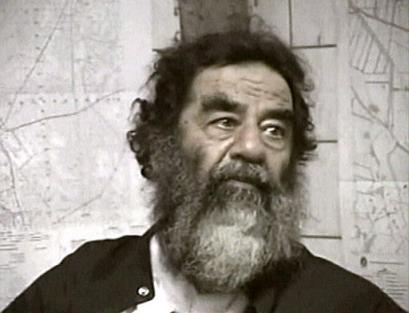
On Sunday December 14, 2003, something amazing happened. While hiding underground in a tiny dirt hole, Saddam Hussein was captured alive by the 4th Infantry Division of American Special Forces. High Value Target Number One was in exactly the kind of condition you'd expect after enduring the nine months of freedom afforded by Operation Enduring Freedom. Saddam's appearance and demeanor were described by infantrymen and reporters alike as dirty, filthy, haggard, homeless, scraggly, scrappy, weakened, weary, and wobbly -- in alphabetical order. George W. Bush's bid to earn just a whisper of his father's approval had finally paid off. "I am Saddam Hussein," the former dictator spoke in fractured boobly English while clutching a small pistol. "I am the president of Iraq and I want to negotiate." The pistol was taken from him without argument, and DNA later confirmed his identity. One soldier replied tartly, "President Bush sends his regards." 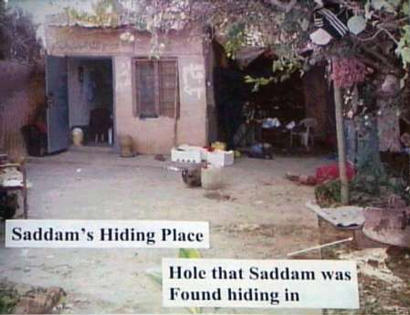
The layout and decor of Saddam's underground hideaway hole were a far cry from his former palaces of indescribable luxury. It turns out family members had given him up, directing intelligence toward a mud-brick hut ten miles south of his childhood home in Tikrit. As troops secured the perimeter, there could be no hiding his warm body from the detection of even third-world infrared scanning techniques. Saddam's rent-controlled "area" was equipped with wall-to-wall dirt and not much of a view. Utilities not included. His Unabomber-sized quarters had one small entrance from above: a filthy piece of flapping cloth and a styrofoam icebox lid painted to look like a concrete slab. Not much of a skylight. Soldiers reported as they descended the ladder, they could hear Saddam scrabbling with rocks, attempting to cover himself up with dirt. Maybe it just should have put the lotion in the basket. What soldiers found was a cave littered in filth and squalor; complete with garbage, plastic bags, empty bottles, rotten fruit and a broken chair. Among the items inventoried from Saddam's hideout: a handful of Bounty and Mars brand candy bars, hot dogs, a can of 7-UP (the un-Cola), a long, black Arab robe, two T-shirts, two pairs of white cotton boxers, a pair of slippers with gold-colored buckles, old textbooks, stale bread, leftover rice, and dirty dishes. How did Saddam breathe down there? Saddam was trapped, "literally like a rat," according to anchorperson Tom Brokaw, and taken prisoner "in a truly pathetic manner." He seemed resigned to his fate, and reaction among the Iraqi community ranged from joy to embarrassment that he hadn't put up a struggle. Former Clinton advisor George Stephanopolus was incredulous, wondering aloud why Saddam hadn't simply killed himself. As images of Saddam being checked for head lice and probed with a tongue depressor were trumpeted across the world in violation of the Geneva Conventions, White House staff declared the Bush administration a "gloat-free zone". NASDAQ surged, but ultimately the capture of a weakened, dottering old man is only vaguely symbolic, and about as politically significant as the inevitable incarceration of Don Knotts. The new Iraqi government, such as it is, wisely jumped ahead of any U.S. statement to declare that Saddam would face a Nuremberg-style show trial for his War Crimes. Charges of genocide were filed in July 2005, and the trial lurched along for nearly a year and a half, through two hunger strikes and the deaths of several attorneys, before reaching a verdict of guilty. Saddam was executed by hanging on the morning of 30 December 2006.
Timeline
|
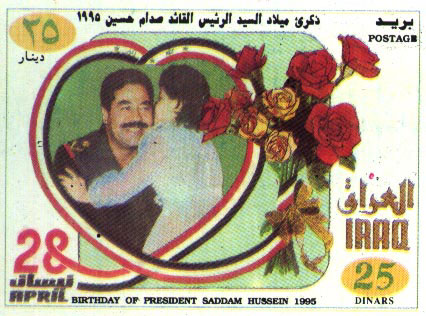 Hussein flitted in and out of exile for several years, attending law school in order to sharpen his blood lust. Like
Hussein flitted in and out of exile for several years, attending law school in order to sharpen his blood lust. Like 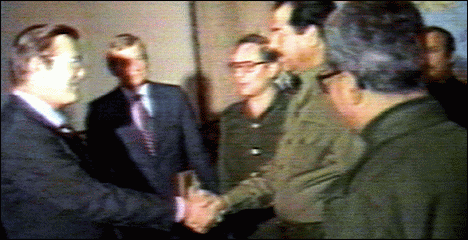 In the late 1980s, Reagan dispatched a very special envoy to the Middle East, one
In the late 1980s, Reagan dispatched a very special envoy to the Middle East, one 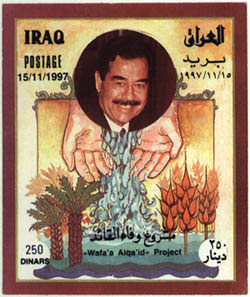 The Iraqi government saw this development differently, according to Saddam's online resume, which includes the bullet point: "Led his country in confrontation the aggression launched by 33 countries led by US which waged war against Iraq, the Iraqis' confrontation of which is called by Arabs and Iraqis as the Battle of Battles (Um Al-Ma' arik) , where Iraq stood fast against the invasion, maintaining its sovereignty and political system."
The Iraqi government saw this development differently, according to Saddam's online resume, which includes the bullet point: "Led his country in confrontation the aggression launched by 33 countries led by US which waged war against Iraq, the Iraqis' confrontation of which is called by Arabs and Iraqis as the Battle of Battles (Um Al-Ma' arik) , where Iraq stood fast against the invasion, maintaining its sovereignty and political system."
 U.S. forces took over the country in fairly short order, but Hussein and his sons were nowhere to be found. Once or twice a week, the U.S. news media engaged in an orgy of speculation that the dictator was finally dead, but he kept on resurfacing in tapes and broadcasts, urging the Iraqi people to resist the U.S. occupation.
U.S. forces took over the country in fairly short order, but Hussein and his sons were nowhere to be found. Once or twice a week, the U.S. news media engaged in an orgy of speculation that the dictator was finally dead, but he kept on resurfacing in tapes and broadcasts, urging the Iraqi people to resist the U.S. occupation. 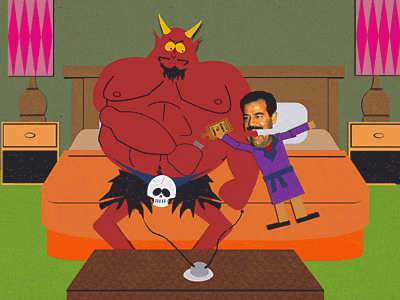 With all this evil to perpetrate, you wouldn't think Saddam Hussein would have had a lot of spare time on his hands, but his literary output suggests otherwise. He wrote a romance novel after the first Gulf War, called "Zabibah and the King," about a kind-hearted leader whose virtuous bride is raped and killed by a painfully unsubtle allegorical stand-in for the U.S.
With all this evil to perpetrate, you wouldn't think Saddam Hussein would have had a lot of spare time on his hands, but his literary output suggests otherwise. He wrote a romance novel after the first Gulf War, called "Zabibah and the King," about a kind-hearted leader whose virtuous bride is raped and killed by a painfully unsubtle allegorical stand-in for the U.S.
 A tin exhaust pipe strung up with salami and figs served as a ventilation duct. Outside the hole, a ditch appeared to have been set up as a makeshift toilet. Also confiscated were two AK-47 rifles and $750,000 in U.S. currency. Not even Saddam trusts the Euro.
A tin exhaust pipe strung up with salami and figs served as a ventilation duct. Outside the hole, a ditch appeared to have been set up as a makeshift toilet. Also confiscated were two AK-47 rifles and $750,000 in U.S. currency. Not even Saddam trusts the Euro.